|
|
|
Braga is marked by a long clerical history. Consequently, Braga is bristling with churchs and monasteries. In addition, it is the capital of the Minho, the northern and most mountainous part of Portugal. It is the center for the industries of leather, textiles, brick manufacturing, soap making, engineering and smelting.
|
|
|
Bracara Augusta, an important Roman Town, was made into a major capital by the Suebi when they advanced into the area in the 5th century AD. The town was subsequently captured first by the Visigoths, who built the early Christian churches, and then by the Moors. After it was reconquered it grew in properity and became the seat of the archbishop.
|
|
|
The influence of the Catholic Church grew and influenced the richness of the architecture. It is evident in the palace, churches, and military buildings of the 16th century. This influence continues even today. The popular descriptions of the various regions of Portugal goes something like this, "In Braga they pray, in Coimbra they study, in Porto they work, in Lisboa they govern, and in the Algarve they play."
|
|
|
The Bom Jesus do Monte is one of Portugalīs most famous monuments. A baroque flight of stairs and the church itself are carved out of austere grey granite set off by whitewashed walls, a typical example of the northern baroque style. The church was built between 1784 and 1811 in one style. The Stairway of the Three Virtues was built later.
|
|
|
Source, Michelin Tour Book
|
|
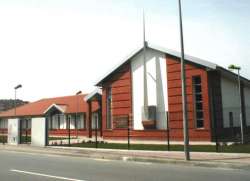
Chapel |
The Braga Chapel was dedicated in November 2003. There was also an Open House at about the same time. The photo on the left is of the chapel and the one on the right is the program for the open house. |
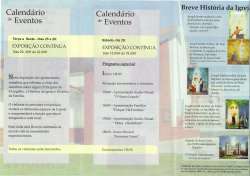
Program |
|
|
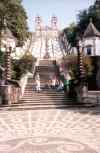
Click for enlargement |
Starting at the base of the passage way you pass through the Holy Way. this is a series of broad hatch back walk ways passing through dense forests. Half way up the trail you arrive at the point where this picture was taken. From here you pass through the Stairway of the Five senses. This is a double staircase with a fountain at each landing. Next comes the Stairway of the Three Virtues. There are fountains for Faith, Hope, and Charity. Notice the patterns in the pavement at the base of the stairs. This is typical of Portugal. The patterns are made from a mosiac of light and dark stone set in a special cement.
|
|
|
This is a close up of the eight flights of stairs. At each level there are fountains depicting each of the senses or virtues. There are also small buildings with dioramas of depicting the various events of the Passion week. There are also many statues of various apostles and prophets of the Bible. It was obvious this was a very popular site because the granite steps were well worn. Notice the mosiac partern in the payment Sister West is standing on.
|
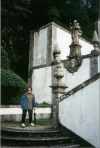
Click to enlarge |
|
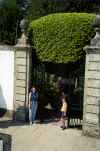
Click to enlarge |
At one of the levels of the stairways there was a wonderful garden shop that sold flowers and plants.
|
|
|
The cathedral at the top of the stairs at Bom Jesus do Monte is surrounded with beautiful gardens and forests. The gardeners change the flowers with the season so that there is always a bright display of color.
|
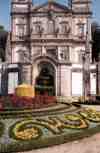
Click for enlargement |
|

Click to enlarge |
There are three ways to arrive at the top of Bom Jesus. First, you can drive. Second, you can walk. Third, you can ride the funicular rail. The funicular rail consists of two sets of cars, one at the top and the other at the bottom. Spring water flows into a tank of the car on top. When it is full, the weight of the water carries the car down and pulls the other one up. Upon reaching the bottom, the water is drained as the other at the top begins to fill with water.
|
|
|
There are many towns north of Braga in the Minho area. However, Braga is the most northern city to have LDS missionaries. The Minho receives the most moisture of any area in Portugal and consequently is the most lush and green. This picture is of one of these towns, Ponte de Lima. It is known for its Roman bridge across the Lima river.
|

Click to enlarge |
|

Click to enlarge |
Nearby Braga is the city of Barcelos. The city has been made famous for its ceramic roosters called "O Galo de Barcelos." The galo has become the unofficial symbol of Portugal. This is a picture of the fair or feira held in the center of the city. You can see the icons lined up. Click here to learn more.
|
|

